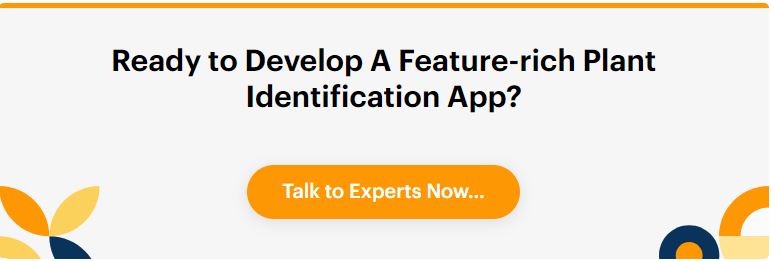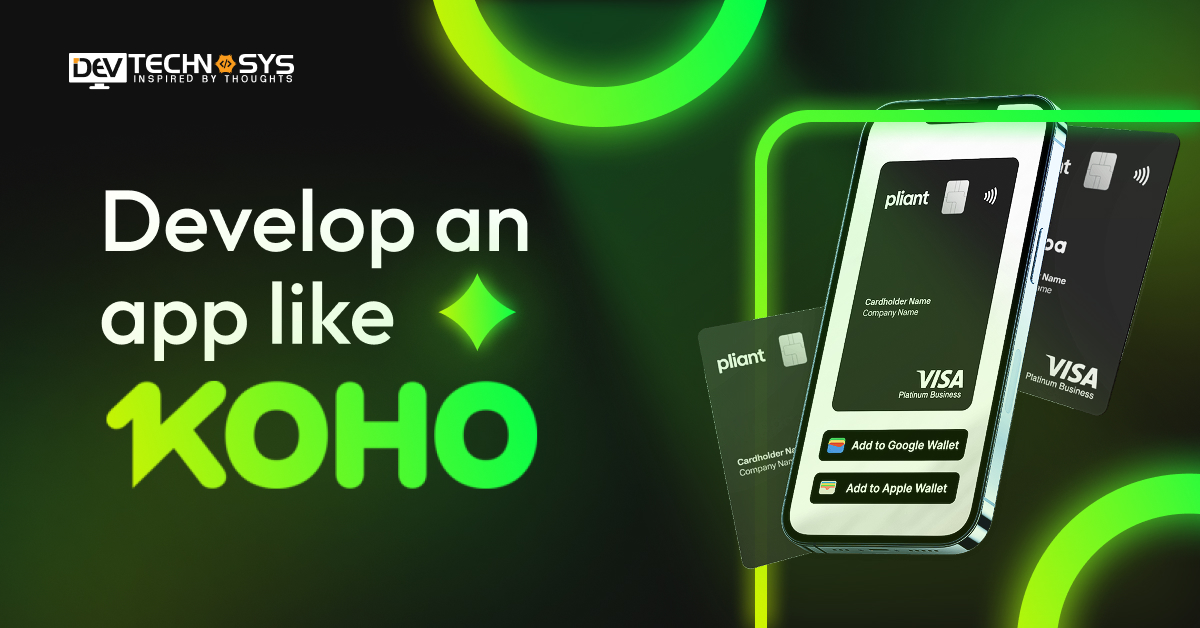Discover the fascinating secrets of one of the most innovative innovations of our time. Welcome to the botanical world where pixels and petals meet and curiosity meets coding. Plant Identification Apps have sparked awe and curiosity in a world increasingly fascinated by the natural wonders around us.
Plant Identification Apps are a window into the green mystery surrounding us in this digital age. Smartphones have become extensions of ourselves. As algorithms and petals entwine together, the question arises: What is the cost to cultivate a digital horticulturist of this calibre?
We will explore the soil of software creation, cultivating an understanding of the seeds that make up the financial landscape. We’ll explore the factors in creating a monetary app, from design to database management.
Come along with us on an expedition where binary code and botany meet. Now is the time to demystify how much it costs to develop a Plant Identification App.
What is a Plant Identification App?
Plant identification apps are software applications that use photos to help users identify different plant species. The plant identifier app uses image recognition software for vegetation identification, often based on machine-learning algorithms, to analyze uploaded photos of plants to provide accurate species identification.
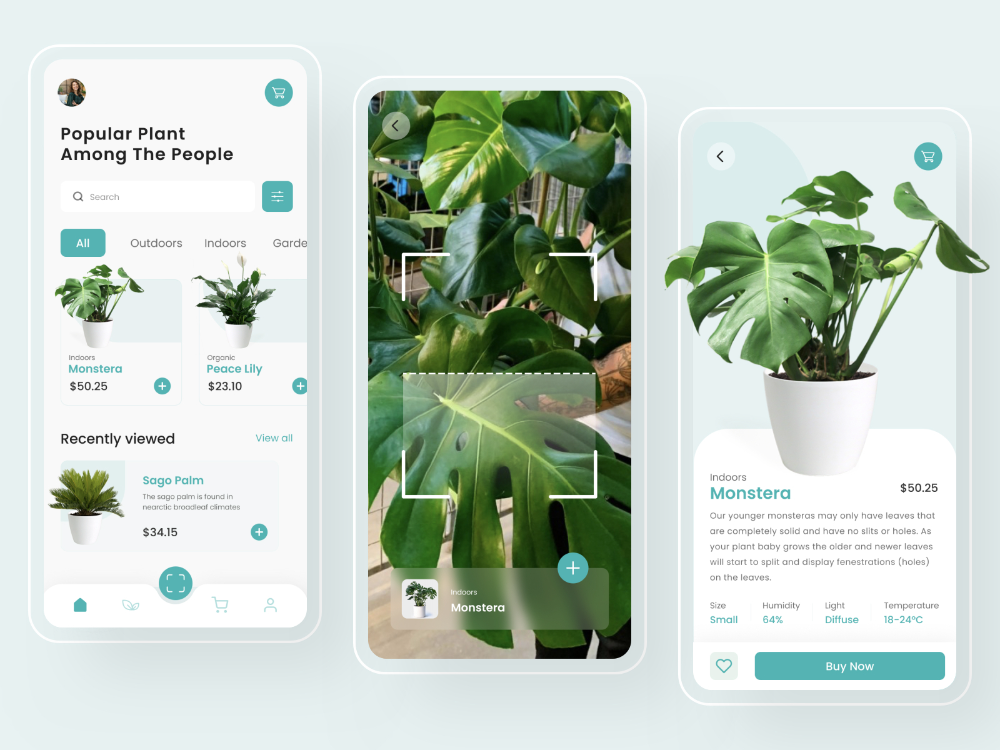
wondering what this plant app can do? Well, these plant identification apps offer extra information, such as scientific and common names, habitat details and care instructions. The app allows users to photograph plants and compare their characteristics with the database.
This gives the user insights into the identity of the plant. Plant identification apps are designed for gardeners, nature lovers, and people curious about plants. Best plant identification apps make learning and identifying the plants they come across easier.
Features That Affect The Cost Of Develop A Plant Identification App
The cost of developing a plant identification app is influenced by various factors, including its complexity and efficiency, which are determined by its features. Here are 15 features that can impact the cost to develop a plant identification app, along with the availability of professional on demand app development services to assist in creating these features.
1. Image Recognition Technology:
have you ever wondered “is there an app to take a picture of a plant and find out what it is?” Yes, there is! the plant identifier app. One of the most essential features of an app for plant identification is its ability to implement advanced image recognition algorithms. The cost depends on the complexity of the algorithm and its accuracy, as well as the training data required.
2. Plant Database:
The value of an app is greatly enhanced by a comprehensive database with detailed information on plant species. The cost of curating and maintaining the database is based on how many species, images and data are included.
3. Designing User Interfaces (UI):
For an app to be successful, it must have a user-friendly and visually appealing interface. The plant ai app cost will be affected by design complexity, user experience, and responsiveness across devices.
4. Augmented Reality (AR):
The user experience can be enhanced by incorporating AR features to identify plants in real time. Costs for best plant care app can be increased by integrating camera functions, image overlays, and real-time processes into AR functionality.
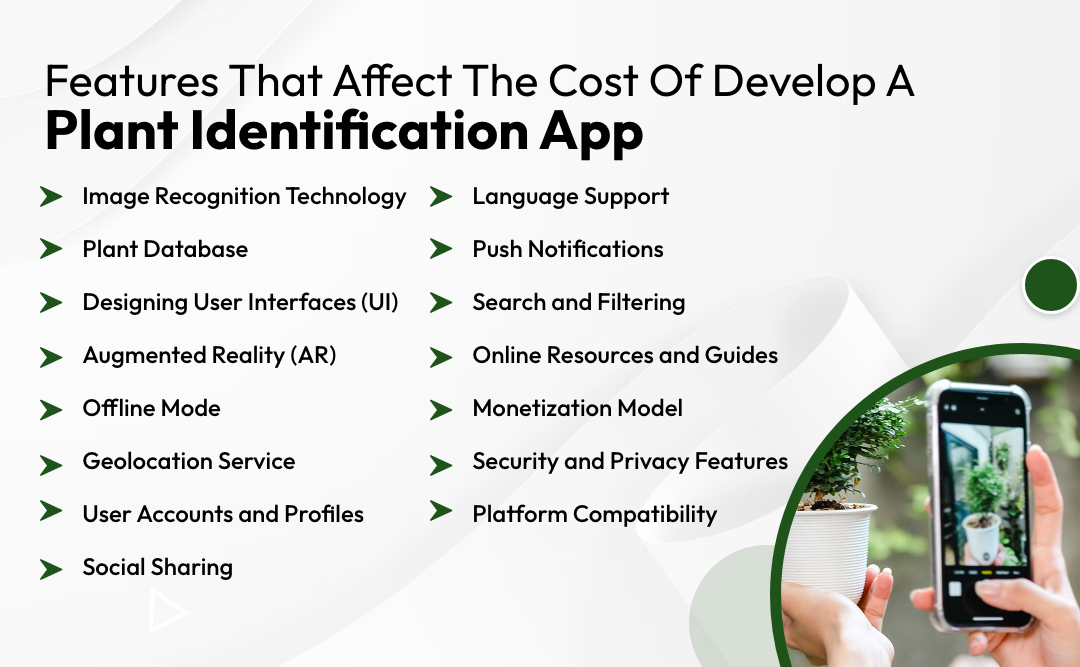
5. Offline Mode:
plant identifier app free of charges offers offline capabilities that are required to allow users to identify plants even without internet access. A local database is also needed. It adds complexity and effort.
6. Geolocation Service:
The integration of mapping APIs with data sourcing and integration increases development costs of a plant identificator app.
7. User Accounts and Profiles:
Backend development and server resources are required to implement user profiles and features such as accurate plant identifications, saved plant lists, plant id, favourite plants, and user-generated content.
8. Social Sharing:
In order to enable users to share their experiences and plant identifications on social media platforms, it is necessary to integrate sharing APIs as well as design seamless sharing options. This will increase the overall cost of development.
9. Language Support:
plant identification app features like language support offer multiple languages. You can translate and adapt the content in the entire app, including the database and user interface.
10. Push Notifications:
Integration of push notifications for tips, reminders, and updates engages users but requires ongoing maintenance and backend setup, which affects development costs.
11. Search and Filtering:
Developing a robust search and filtering tool that allows users to narrow their plant identification by characteristics like colour, size, and habitat takes extra effort and resources.
12. Online Resources and Guides:
The complexity of on demand app development solutions and the costs associated with content creation increase when users are provided with additional resources such as plant care guides, gardening advice, and educational material.
13. Monetization Model:
The decision on the monetization model, whether it is a free app with premium features or ads, impacts development. Each model has different technical requirements.
14. Security and Privacy Features:
The time and resources required to implement robust security measures and data encryption and ensure compliance with privacy laws and regulations are increased.
15. Platform Compatibility:
The cost of developing an app for multiple platforms, such as iOS, Android and the web, is increased because the user interface must be adapted, the coding has to be done, and the testing needs to be performed.
Read More: Best Plant Identification Applications
6 Steps To Build A Plant Identification App
A plant identification app is a fun project that combines artificial intelligence and the natural world. This app, developed in collaboration with a mobile application development company, allows users to identify plant species by simply taking a picture of the plant. Here are six simple steps that will guide you in creating a plant identification app.

-
Define the Scope and Features:
Start by defining the scope and purpose of your app. Choose whether you’d like to develop a simple identification tool or add additional features, such as community forums, plant care tips or a digital journal. Determining the features of your app will help you create a roadmap for its development.
-
Collect and Prepare Data:
A plant identification app’s success depends on correctly recognizing different plant species. To train your machine-learning model, you’ll need a large dataset of labelled plant images from an on-demand app development company. Collaborate online with botanists or horticulturists to collect high-quality photos representing each species’ different angles, growth stages, and variations.
-
Create the Machine Learning Model:
The core of your application is built by an Android app development company training a machine-learning model, most likely convolutional neural networks (CNN), using the data collected.
Platforms like TensorFlow and PyTorch can assist with this task. The model must learn to distinguish the features of different plants to predict when presented with a new picture accurately.
-
Implement User Interface Design (UI Design):
Create a user-friendly and intuitive interface by collaborating with an iOS app development company to allow users to upload and take photos of plants. Focus on the photo-capturing process and keep the design simple. For better accuracy, give users the option of capturing images at different lighting conditions and angles.
-
Integrate API and Backend:
Create the backend for your plant identification app development. This will be responsible for image processing and interaction between the machine-learning model and the results delivered to the user.
Consider developing a RESTful interface that your app’s front end will be able to communicate with. This API is responsible for receiving images and forwarding them to a model. It will also receive predictions and send those predictions back to your app.
-
Test, refine, and Deploy:
It is essential to test your green plant identification app to ensure accuracy and usability. Start with internal testing. Hire a mobile app developer to test the app to identify bugs, glitches or inconsistencies.
Once these problems are resolved, you can conduct beta testing on several users to collect feedback and make improvements. Continue refining the model based on user feedback to improve its accuracy and reliability.
How Much Does it Cost to Develop A Plant Identification App?
The cost of developing the best app for plant identification is affected by many factors, such as the complexity, features, design and development team. if you want to know how much is plant identifier app cost? then read the section below. In this section, we will examine the factors that affect the cost of creating a plant identification app and give a rough estimation.
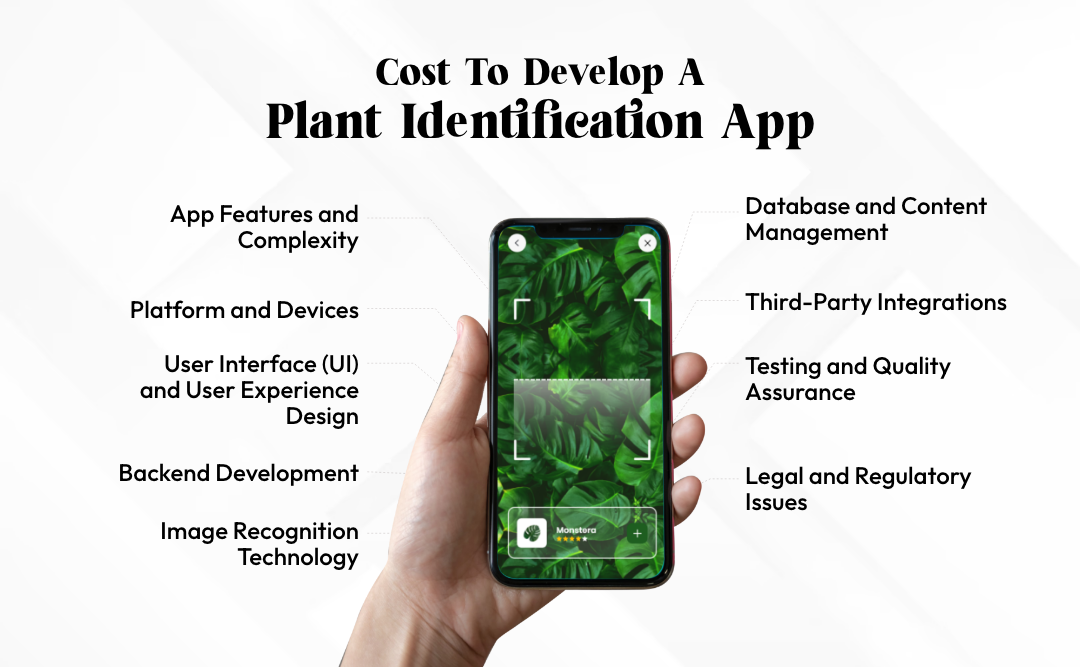
1. App Features and Complexity:
The cost of plantin app will be affected by the features you wish to include in your best plant identification app. Some basic features include image recognition, plant identification, and image capture. Complexity and development time can be increased by adding advanced features like social sharing, plant-care advice, offline mode and augmented reality.
2. Platform and Devices:
The plantum app cost will depend on whether you develop a plant identification app for one platform (iOS) or two platforms (Android). The cost and effort of developing an app will be affected by whether it is developed for a single platform (iOS or Android) or both.
3. User Interface (UI) and User Experience Design (UX):
Your app for plant identification success depends on a well-designed, user-friendly interface. UI/UX designers will be needed to design icons, layouts and create an intuitive user experience. It will add to the cost of developing a plant identification app.
4. Backend Development:
Building a robust backend that supports features such as storing user data and managing plant databases is important. The development cost of the plant identification app will be affected by the complexity of the backend and the chosen technology stack.
5. Image Recognition Technology:
Image recognition is the heart of the best apps for plant identification. The cost of licensing or implementing a reliable API or technology for image recognition can be high.
6. Database and Content Management:
It takes effort to maintain a comprehensive database of plants and ensure that it is regularly updated. Collecting images of plants, scientific data, common names, and care instructions is essential.
7. Third-Party Integrations:
The cost of the plant identification app Android will increase if you integrate third-party services such as social media sharing, payment portals (for premium features) and analytics tools.
8. Testing and Quality Assurance:
It is essential to thoroughly test the plant identification app on different devices and scenarios. QA testing, bug fixes, and ensuring the app is safe from potential threats are ongoing processes that add to the costs.
9. Legal and Regulatory Issues:
Legal and regulatory requirements may be relevant depending on the functionalities of your app and where you plan to launch it. It could affect both development costs and ongoing maintenance.
Let’s now provide a rough estimate of the cost to develop a mobile app using these factors. These estimates are only a guideline and can change significantly depending on your project’s specifics and market rates. take a look at below table to picture this plant identifier cost with affecting factors.
Factor |
Estimated Cost Range |
| Basic Features | $1,000 – $3,000 |
| Advanced Features | $2,000 – $4,000+ |
| Platform (Both iOS and Android) | $2,000 – $3,000+ |
| UI/UX Design | $1,000 – $2,000 |
| Backend Development | $1,000 – $4,000+ |
| Image Recognition Technology | $1,000 – $4,000+ |
| Database and Content Management | $1,000 – $2,000+ |
| Testing and Quality Assurance | $1,000 – $3,000+ |
| Legal and Regulatory | Variable |
| Total Estimated Cost Range | $10,000 – $25,000+ |
Several factors determine the cost of developing a plant identification app. The mobile app development cost can vary greatly depending on factors such as the platform, design, technology stack and complexity of the features.
To ensure that your plant identification app is successful within your budget, it’s essential to plan out all the features and functions of your app and to hire dedicated developers. Remember to include the cost of ongoing maintenance, updates, and marketing campaigns in your budget.
Conclusion
The cost of developing an app for plant identification can vary greatly depending on features, platform, level of complexity and rates charged by the plant identification app development services. More basic apps could start at around $10,000, while those with higher levels of complexity can exceed $30,000.
Also, consider the ongoing maintenance and updates. For accurate budgeting, it is important to conduct thorough research and plan. Remember that investing in quality will lead to a user-friendly and flourishing app. So if you are one of the people who want to build a plant identification app, hire a plant identification app development company.
Frequently Asked Questions
Q1. What Factors Influence The Price Of Developing An App For Plant Identification?
App complexity, platform (iOS/Android), android app development services cost, and design complexity affect costs.
Q2. What Is The Cost Range Of A Basic App For Plant Identification?
A simple mobile app development in botany could cost anywhere between $10,000 and $30,000. It includes a primary user interface and core identification functionality.
Q3. What Is The Cost Of A More Sophisticated Plant App That Has Additional Features?
A mobile app with features such as social sharing, detailed plant profiles and AI improvements can cost anywhere between $8,000 and $30,000.
Q4. Does The Use Of Pre-Existing Databases Of Plants Affect Cost?
Yes. Using existing databases can help reduce costs. However, integration and curation of the data require some development effort.
Q5. Are There Ongoing Costs After The Initial Development Of An App?
Yes. Updating the app and maintaining servers, as well as addressing feedback from users, are ongoing costs. Budget for improvements and support after launch.



